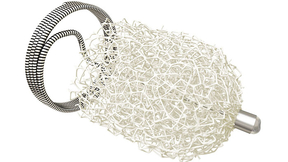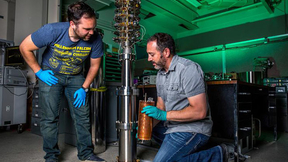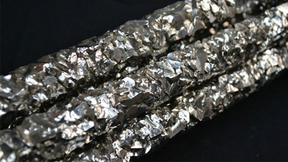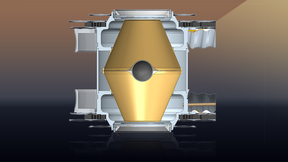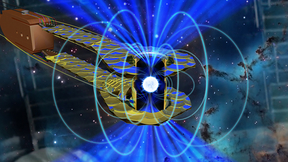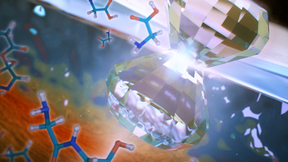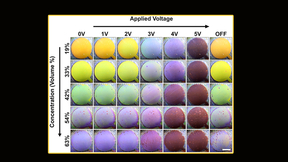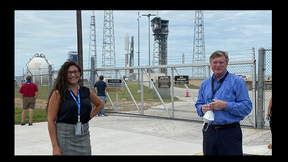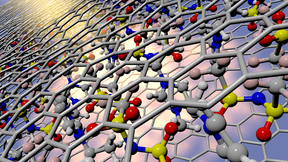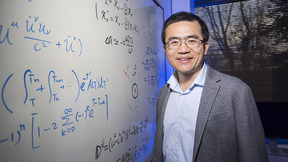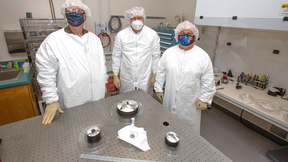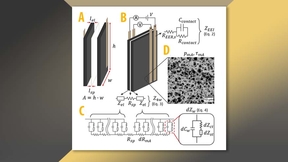Back
Physical and Life Sciences
R&D 100 Winner: Expanding Embolization Success
Scientists from Livermore and Texas A&M University, along with California-based startup Shape Memory Medical, Inc., have improved upon existing technologies with the IMPEDE® embolization plug, winner of a 2019 R&D 100 Award.
Tuning into Dark Matter
Lawrence Livermore researchers and collaborators are searching for the axion—a low-mass particle that could make up the majority of dark matter.
A Revelation in Nuclear Science
Livermore scientists, in collaboration with university partners, are studying ways to harvest rare isotopes, including a radioactive isotope of the element zirconium.
Scientists encouraged by Frustraum experiments at NIF
Initial NIF experiments using a full-scale version of the Frustraum hohlraum have produced nearly round inertial confinement fusion (ICF) implosions and more laser-induced energy absorption by the fuel-filled capsule. National Ignition Facility (NIF) researchers are optimistic that results from the initial tests of the novel angular-shaped hohlraum could create more…
Neuronal cultures advance ‘brain-on-a-chip’ technology
Lawrence Livermore National Laboratory (LLNL) researchers have increased the complexity of neuronal cultures grown on microelectrode arrays, a key step toward more accurately reproducing the cellular composition of the human brain outside the body. As described in a recently published paper in Scientific Reports, an LLNL team led by biomedical scientist Heather Enright…
Record EOS measurement pressures shed light on stellar evolution
Using the power of the National Ignition Facility (NIF), the world’s highest-energy laser system, researchers at Lawrence Livermore National Laboratory (LLNL) and an international team of collaborators have developed an experimental capability for measuring the basic properties of matter, such as the equation of state (EOS), at the highest pressures thus far achieved in a…
Compressive shearing may start life on other planets
Massive compressive shearing forces generated by the tidal pull of Jupiter-like planets on their rocky ice-covered moons may form a natural reactor that drives simple amino acids to polymerize into larger compounds. These extreme mechanical forces strongly enhance molecule condensation reactions, opening a new arena of possibilities for the chemical origins of life on…
Doctoral fellow improves codes used to simulate interactions between particles moving at high velocities
Doctoral student Marco Echeverria is spending his second summer conducting research for Lawrence Livermore National Laboratory (LLNL), but this year his summer experience is taking place at a distance — from his home in Connecticut. Echeverria is one of hundreds of LLNL summer students who needed to shift to a virtual internship or fellowship due to the pandemic. “The…
LLNL researchers achieve greater understanding of color origins in low-power electronic displays
Today’s low-power, electronic ink displays such as e-book readers produce text through a process called electrophoretic deposition (EPD). Each pixel of the display contains charged black and white particles suspended in a liquid solvent. These particles are moved by electrodes embedded in the devices, causing particles to stick to the electrodes to form words or images…
Lab assists in NASA launch of Mars rover
When an Atlas V-541 rocket lifted off Thursday morning (July 30) for Mars from Cape Canaveral Air Force Station with the Perseverance rover in tow, two Lawrence Livermore National Laboratory (LLNL) scientists had front row seats. The pair, Steve Homann and Jessica Osuna, researchers in the Lab’s National Atmospheric Release Advisory Center (NARAC), part of the Nuclear…
3D nanometer-thin membrane borrows from biology
Mimicking the structure of the kidney, a team of scientists from Lawrence Livermore National Laboratory (LLNL) and the University of Illinois at Chicago (UIC) have created a three-dimensional nanometer (nm)-thin membrane that breaks the permeance-selectivity trade-off of artificial membranes. Highly permeable and selective membranes are useful for a wide range of…
Carbon emissions, energy flow charts for all U.S. states
Lawrence Livermore National Laboratory (LLNL) has updated its energy flow charts to include state-by-state energy use for 2015-2018. It also has released carbon emissions charts that depict a breakdown of all 50 states’ carbon emissions from 2014-2017. See the charts. Each year, LLNL releases flow charts that illustrate the nation's consumption and use of energy. This…
Diving into the structure of molten salts in tight spaces
Room temperature ionic liquids (ILs), a special class of molten salts, promise far greater electrochemical performance compared to conventional aqueous solutions due to a suite of novel and tunable properties. Over the past two decades, ILs have been explored as a means of improving a range of different technologies, from energy storage and conversion to catalysis to…
New analysis narrows range in climate sensitivity
The most advanced and comprehensive analysis of climate sensitivity undertaken has revealed with more confidence than ever how sensitive the Earth’s climate is to carbon dioxide. Climate warming depends on the changing composition of the atmosphere, and the “climate sensitivity” represents the dominant indicator of change, defined as the increase of global air temperature…
Lab scientist wins outstanding doctoral thesis award
Lawrence Livermore National Laboratory (LLNL) physicist Yuan Shi has earned the American Physical Society’s (APS) Marshall N. Rosenbluth Outstanding Doctoral Thesis award for his work in plasma physics. The award recognizes exceptional young scientists who have performed original thesis work of outstanding scientific quality and achievement in plasma physics. The citation…
Lawrence Livermore, Tyvak Systems announce agreement to develop telescopes for nanosatellites
Lawrence Livermore National Laboratory (LLNL) and Tyvak Nano-Satellite Systems Inc. have reached a cooperative research and development agreement (CRADA) to develop innovative compact and robust telescopes for nanosatellites. The four-year, $2 million CRADA will combine LLNL’s Monolithic Telescope (MonoTele) technology with Tyvak’s expertise producing high-reliability…
E-waste-eating protein extracts rare earth elements
Lawrence Livermore National Laboratory (LLNL) researchers, in collaboration with Pennsylvania State University (PSU) and Idaho National Laboratory (INL), have designed a new process, based on a naturally occurring protein, that could extract and purify rare earth elements (REE) from low-grade sources. It could offer a new avenue toward a more diversified and sustainable…
Increases in greenhouse gas, particulate pollution emissions drive regional drying around the globe
Despite devastating impacts of drought on human and natural systems, the reasons why long-term regional drying occurs remain poorly understood. Research led by Lawrence Livermore National Laboratory (LLNL) scientists has identified two signatures or “fingerprints” that explain why arid conditions are spreading worldwide, and why the Western United States has tended toward…
Expanding Embolization Success
Scientists from Livermore and Texas A&M University along with California-based startup Shape Memory Medical, Inc., have improved upon existing technologies with the IMPEDE® embolization plug, winner of a 2019 R&D 100 Award.
Summer students shine in desalination research
Capacitive deionization (CDI) is an emerging class of water desalination technologies that use cyclic charging and discharging of electrodes to reduce or enrich the salinity of incoming water. The desalination characteristics of CDI are strongly influenced by the resistive components of the system. To better understand this process, a team of Lawrence Livermore National…


